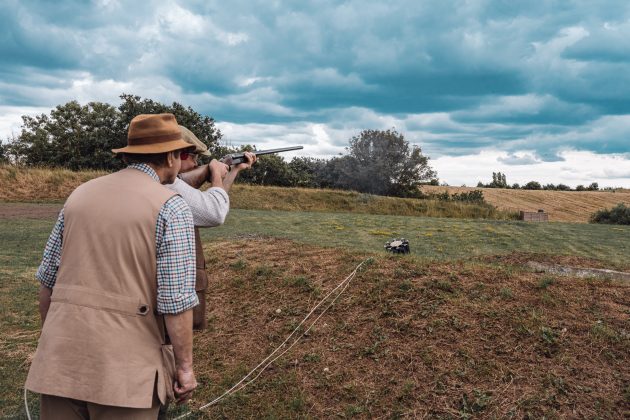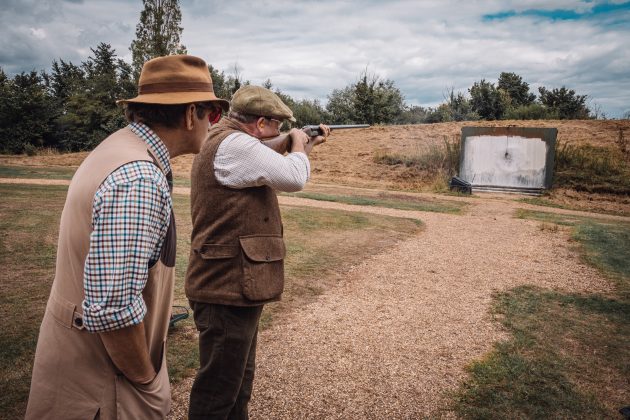Understanding eye dominance is key to becoming a first-class shot but how do you identify your master eye and why does it matter? Michael Yardley explains all
Eye dominance is integral to being a top shot but it is also often misunderstood and oversimplified. For those keen to shoot well, you need to know what your eye dominance is as precisely as possible. It can change suddenly or over time and have a huge impact on shooting. Men may experience changes of eye dominance in mid-life, while many women have visual issues that are never properly diagnosed.
HOW TO IDENTIFY YOUR OWN EYE DOMINANCE
Age and gender apart, fatigue, ill-health and certain activities (computer work, for example) may affect eye dominance. If you have strings of inexplicable misses, if some targets always escape you, or if you have days when you cannot hit a thing, it is worth considering whether eye dominance may be the explanation. Similarly, if you experience any sense of visual confusion when shooting.
Poor gunfit (too low a stock – perhaps only becoming evident at higher elevations) may also lead to apparently unaccountable shifts because vision to the eye that should be looking down the sighting rib is impeded by the mass of the action, causing the eye opposite the rib to take over.

To further complicate the issue, there may be a learned element to eye dominance that is not yet well understood. If, for example, people in different sports are tested, a different distribution of eye dominance may be noted. It is as if the activity itself can change eye dominance.
For most adult men, shooting is easier with both eyes open. If their eye dominance matches absolutely or nearly their handedness, with good gunfit and basic technique, they can shoot from the writing/strong-hand shoulder with the same eye controlling the pointing. Natural hand-eye coordination is enhanced, allowing for precise location of the target in three-dimensional space. If you fall into the happy category of having eye dominance that matches your handedness, you are lucky from a shooting perspective.
If the shot has an opposite eye that is dominant (cross-dominance), both eyes are equally dominant (central vision) or there is some other condition other than absolute dominance in one eye, they cannot shoot from their writing/stronghand shoulder keeping both eyes open unless their stock is modified or some other strategy is employed. If they attempt to shoot with both eyes open all the time, they may align the barrels with the wrong eye, causing a massive aiming error, or suffer from visual confusion (for example, seeing two sets of barrels and not knowing which to use for alignment).
Most (not all) women, the majority of pre-teens of both genders, and a significant minority of men do not have one eye that predominantly directs their pointing. Usually they would all be ill-advised to shoot with both eyes open all the time (although some may be able to pick up the target with two eyes). Advice for teenage boys may change too. In adolescence, the majority will go on to develop absolute eye dominance. A large proportion of women (again, not all), as most boys and girls, tend to have what might be called ‘indeterminate eye dominance’, where both eyes seem to fight for control, or have another factor contributing to conscious or unconscious visual confusion.
ROUTINE TESTING FOR EYE DOMINANCE
There are some simple tests one can carry out to determine the master eye:
POINTING
Begin by asking the testee if they are right- or left-handed and whether they have any tendency towards ambidexterity (if they answer ‘yes’, it is often an indication that they will not be absolutely dominant in one eye). Next, ask them to stand about five to 10 yards away and square on. Indicating my own master eye with a finger as a mark, I will ask the testee to point with their preferred hand and extended arm/hand/finger at this. It is important that they keep both eyes open. The procedure is repeated with the other hand. Usually the master eye, or predominant master, is quickly apparent. Sometimes, however, the results with right and left hands are different.

The test routine then progresses to quick pointing: “Let your arm fall by your side and come up quickly to my eye.” This quick-point test can be used to confirm a provisional diagnosis, or it may reveal that an apparently non-dominant eye is nevertheless having some significant effect. The most common example is a slight pull towards the opposite eye as the finger comes up (often followed by a subtle correction that would go unnoticed without this close observation).
If the testee is lining up with one eye all the time, no matter which hand is used and no matter the tempo of pointing, it is probable (though still not definite) that this eye is the master. The person with true central vision – a rare condition – will point confidently at you with a finger that appears to be in line with the bridge of their nose from your point of view. If you note, however, that the person being tested is having significant difficulty pointing (as you will see with indeterminate eye dominance), if the finger is moving around and not settling, if you note slight corrections being made (typical of predominant dominance), if the testee tends to squint one or other eye when trying to line up, or if there is a tendency to line up with one eye with one hand and with the opposite eye with the other, it is probable that eye dominance is not absolute.
THE CIRCLE TEST
Ask the subject to make a circle by bringing the tips of the thumb and forefinger together while extending the hand and arm as far as possible (a dedicated tool may be created to aid testing with a ring attached to a handle). Again, the test is repeated for both right and left arms/hands. Circle tests are helpful because the tester can see if the eye is centred in the circle (indicating absolute dominance) or to one side consistently (indicating predominant dominance and possibly the need for extra cast on the gunstock). The circle test makes subtle differences clearer.

SHOOTING
No final diagnosis or prescription should be confirmed without watching the testee shooting, both at a mark on a pattern plate and at clay targets (some presentations particularly suit this purpose, such as straight going-away birds, true crossers from right and left, and birds driven straight and slightly right and left of centre. Rabbits may also highlight eye dominance issues).

HOW TO DEAL WITH EYE DOMINANCE ISSUES
Not everyone shoots as the first test indicates. Many experienced shots have subtle eye-dominance issues that only take effect in certain situations. Gross eye-dominance problems (quickly spotted by any competent instructor) might include being a yard in front of crossers from one side but a yard behind those from the other. More subtle issues may require Holmesian levels of observation.
Squinting an eye at the moment or just before a shot is taken can be a simple fix – and one, if successful, indicating a possibly undiagnosed issue. For those who cannot easily close or squint an eye, a small spot carefully positioned or painted on to shooting glasses can do the trick. It needs to be located precisely, though, with head down on the stock in a normal shooting position, and the spot placed directly over the pupil as vision is maintained forward, looking along and beyond the rib. The spot must not be too small – about half an inch carefully positioned is ideal – and allowance must be made for head movement. Another remedy, advised by Robert Churchill, is to raise the thumb of the front hand. It has the same effect: to block vision to the ‘wrong’ eye at the critical moment.
DIAGNOSES AND PRACTICAL ACTIONS
Having established your eye dominance, there are a series of measures that can mitigate its impact on your shooting success in the field or on the clay ground
PREDOMINANT DOMINANCE
One eye clearly in control but with some interference evident from the opposite eye. Both eyes should be kept open with appropriate cast on the stock, or you can dim or close an eye as the barrels come to the bird. The bird should be picked up with both eyes open if possible and comfortable.
TRUE CROSS-DOMINANCE
Squint or close the eye opposite the sighting rib as the shot is taken, or block vision to it by some means. Other options include a full cross-over stock (as once delighted gunmakers), a parallel rib (as used by some clay shooters still and first described by Greener) or changing shoulders (effective but usually best done early in a shooting career).

OCCASIONAL CROSS-DOMINANCE
May be caused by a low stock or other causes as noted (fatigue and so on). Some just seem subject to it occasionally. It can be induced by certain targets. It is most frequently seen on slower right-to-left presentations for right-handed, normally right-master-eyed, shots. The problem may be aggravated by poor focus discipline or eyesight issues. The quick ‘cure’ is to squint as you take the shot.
CENTRAL VISION
Where both eyes are equally dominant is, usually, obvious from a pointing test. My advice is to close the eye opposite the sighting rib or block the vision to it by some means (such as modified shooting glasses with an obturating spot carefully placed). A semi cross-over stock may also be considered (like a full cross-over, these are expensive and rarely seen today).
INDETERMINATE EYE DOMINANCE
This is where both eyes fight for control, common in women, girls and pre-teen/ adolescent boys as noted and frequently misdiagnosed as central vision. Again, the vision to the eye opposite the rib will need to be blocked by one means or another. Interestingly, squinting may be difficult for those affected; consider modified shooting glasses or, temporarily, an eye patch.
FLUCTUATING/SHIFTING EYE DOMINANCE
This might impact any of the cohorts previously mentioned. An individual identified as having one dominance type may shift to another. It may be situational, related to equipment as noted in occasional cross-dominance, or it may occur for reasons not completely understood. Some seem more prone to these shifts than others.

Advice would include improved awareness and focus discipline whatever else. Dimming an eye may correct alignment and offer self-diagnostic help. There are various accessories available for those with eye-dominance problems. Handguards for side-by-sides incorporating an obturator looking like one of Mickey Mouse’s ears used to be quite popular. Special sights are available that may only be seen by the eye looking down the barrel. The latest clever device on offer is the SP – essentially a small, self-adhesive paraboloid protrusion designed to be attached near the muzzles on the side of the barrels or joining rib. It is intended to give a subconscious cue in peripheral vision to the eye looking along the rib.
BINOCULAR VISION AND MOVING OBJECTS
To shoot effectively, we must locate, centre and sustain focus on a moving object. The visual act begins when the rod cells in the peripheral region of the eye first pick up movement of an object in the field of vision (a primal response to potential danger). This induces a ‘saccade’, a reflexive flick of the eyes, towards the movement. The ‘extraocular’ (external) muscles then lock vision on to the moving object in pursuit as internal ‘ciliary’ muscles adjust focus and, by altering the size of the pupil, light levels.
Humans have a highly evolved binocular vision system to facilitate this ‘targeting’. It increases our field of vision and allows for better judgement of distance, speed and angle, also facilitating hand-eye coordination. To maintain the perception of a single image, however, requires higher cognitive processing and the precise coordination of eyeball movement. This may be inward (convergent) or outward (divergent). Divergent eye movement is common in shotgun shooting because the target is typically retreating from the eye.
Squints, defects in the nervous system and severe refractive errors may cause binocular vision to break down, with double vision (diplopia) resulting. However, double images in our peripheral vision are quite normal. This may be simply demonstrated. Point at an object at distance with an extended arm/index finger and focus hard upon it. Most will see two images – the main image and a ghostlike one to the side (which may not have been noted initially).
If your focus converges back on to the finger, the two images will merge into one. We have an innate or learnt ability to suppress one image from consciousness. When this does not happen, visual confusion can result, and it explains some shooting problems.
Michael Yardley is a Fellow of the Association of Professional Shooting Instructors and may be contacted via yardleypen@aol.com




